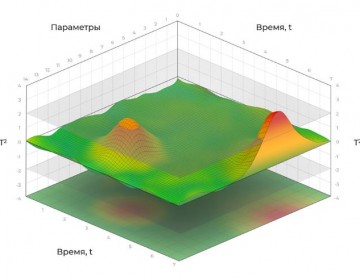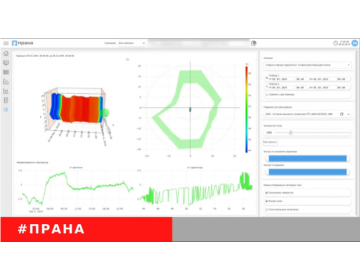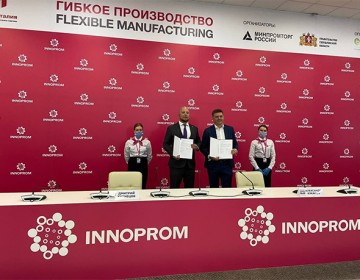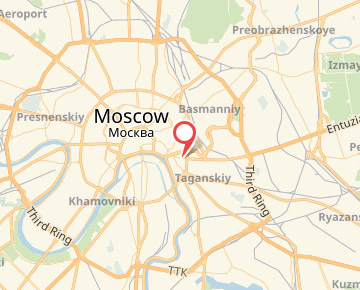Experience in use of remote access and predictive analytics for power equipment’s condition
The fourth industrial revolution based on information technology and proclaimed in 2016 by Prof. Klaus Schwab at the World Economic Forum in Davos is also entering into the Russian power engineering. Digital systems are being introduced, i.e., the systems of automatic control of frequency and power, the prediction and remote monitoring systems (PaRMS) of equipment of modern power-generating units based on industrial Internet technologies.
Reducing the failure rate at the power engineering objects is an important problem, the solution of which makes it possible to reduce economic loss as well as improve the equipment effectiveness. One of the methods of reducing the failure rate is the connection of power plant equipment to modern monitoring systems. To apply the PaRMS, the equipment of modern gas-turbine plants (GTP), steam- and steam-gas power-generating units, are sufficiently equipped with a metering apparatus or an automatic control system of technological process (ACS TP), making it possible to read information in digital form to analyze the behavior of the object and its components by direct or implicit data from monitoring devices.
The following systems of remote monitoring and diagnostic designed to detect the change in operable operating condition of power equipment are available on the Russian market: SmartSignal, GE; SPPA-D3000 Plant Monitor, Siemens; EtaPRO GP Strategies/Rovsing Dynamics; Avantis PRiSM Schneider Electric; pSeven DATADVANCE. Different mathematical methods of predictive analytics are used in these systems, which are listed below:
- detections of similarity of variables (SBM— similarity based modeling);
- neural networks;
- main components;
- uzzy logics; and
- gradient booster immunization of decision trees.
In contrast to the regular ACSs TP, the PaRMSs make it possible not only to collect and transmit the data but also to process them for prediction and failure prevention. The PRANA prediction and remote monitoring system [1] is one of the domestic developments. It makes it possible in real-time to record the changes in operating conditions and predict the terms of exceeding the parameter values to the limits of warning and alarm signaling. Thus, PRANA solves another problem: it determines the terms of repair of power-generating equipment and its units and, as a result, the transition to service according to the operating condition. Figure 1 shows an example of detection of an operating condition change 2 months before the parameter reaches the value causing the warning signaling triggering.
Prana prediction and remote monitoring system
The PRANA (PRedictive ANAlytics) system is a predictive and remote monitoring system for continuous control, diagnosis, and prediction in the change of operating conditions of power-generating equipment developed by the AO ROTEK specialists.
The system has two levels: upper and lower. The lower level is the thermal power station. The lower level system provides the data reading from the ACS TP of the object, storage of these data, preliminary processing, and transfer by a secure channel to the upper level.
Recording of operational parameter values is carried out at the monitoring object using sensors with which the equipment is equipped. The readings from the sensors are transmitted to the primary controllers and archive server of ACS TP. The data transfer from the archive server of ACS TP into the server of the lower level of PRANA is carried out using OPC protocol (Open Platform Communications). The security zone is organized using firewalls for the server of the lower level of the PRANA system.
The upper level is the RMC (remote monitoring center), where analytical processing data and visualization of analysis results on symbolic circuits is carried out. The server-to-server synchronization procedure between the servers of the upper and lower levels is used to transfer data. The connection of a customer and of workers of a thermal power plant to the user interface is accessible by a thin client technology (through a browser).
The algorithm underlying the system is based on building the operation model by statistical data. The current condition of the unit is compared with the model in real-time. The PRANA system for implementing the models of power-generating equipment uses a special variant of the SBM methods family: the MSET method (Multivariate State Estimation Technique) [2]. The difference of vector of arguments from the vector to be calculated by the MSET method of the model in this method is evaluated by the T2 Hotelling criterion. The influence of separate arguments on the deviation from the model in the case of violation of T2 criterion is evaluated using the maladjustment calculation by the MSET method. The modeling is performed online. The MSET method is also used offline as an additional device for analysis.
The reference model is created for operation of serviceable equipment, with whose use there are no negative trends associated with natural wear or origin of defects. The ideology of the control Hotelling T2 - cards is used to build the reference model. The time sections are chosen by each parameter corresponding to the minimum, maximum, and median values. The vectors of these time sections make up a learning state matrix. For each vector component, a similarity operator of values is introduced taking into account the range of changing the components in the sample, and the similarity operator of matrices is introduced using the similarity operator of components. According to the state matrix and using the similarity operator for each vector of measured values, the vector of the model is calculated by expansion of the measured vector by the vectors of the state matrix.
By the difference of reference and measured values for each parameter, its discrepancy and the standard deviation are calculated. The discrepancies are normalized, and the integrated quantity—T2 criterion—is calculated by their aggregate. When changing the dependences of measured values, this amount increases substantially. Thus, the reference model is the vector-function of the vector on arguments— parameters. The analysis of T2 -criterion makes it possible to predict the changes of operating condition of equipment and reveal the previously unknown dependences of parameters.
The MSET method is universal as applied to the equipment of various types. It was initially used to monitor the equipment condition at foreign nuclear power plants, but its universality and flexibility make it possible with ease to introduce it in different fields where reliability and efficiency have a high priority. The equipment of the whole power-generating unit of the SGP (steam gas plant) can additionally be connected to the PRANA system. The AO ROTEK specialists developed models of the boiler—utilizer, the steam turbine (ST), and the gas booster compressor using archival data of the power-generating unit of the PGU-450 type.
Symbolic circuit of predictive monitoring
In the lower left corner of Fig. 2, there is an event log window. The T2 criterion exceeding the acceptance limits and changing the operation mode of turbounit are represented as the events. The PRANA system recognizes not only the parameters owing to which the model exceeds the bounds but also calculates their weight functions, i.e., the contribution of each parameter into the maladjustment process of the reference model.
According to the results of the event log when the «Report» button is clicked by the user’s demand, instant reports, summary reports with the results of operation for the day, week, month, or for any selected time interval can be automatically formed and transmitted by e-mail to customers.

Fig. 1 Determination of equipment repair terms using the PRANA system

Fig. 2 Symbolic circuit of PRANA predictive monitoring system
Symbolic circuit of technological monitoring
Besides the analytical symbolic circuit, there are technological symbolic circuits in the user interface (Fig. 3) intended for additional turbine control. They contain the circuits of turbounit subsystems as well as the digital indicators of essential parameters. When the cursor points to the selected indicator, one can click the left mouse button to display the diagrams of parameter dependences on time. The window contains a drop-down list and buttons to add the diagrams and scaled-up viewers.
For user convenience, the click and drop method is implemented. It is a possibility to add the desired parameter into the already existing diagram by simply clicking its indicator. In addition, the diagrams of dependence not only on time but also on the desired parameter are graphed. For that purpose, it is necessary to click «XY Diagram» and select the desired parameters. These devices are convenient for detailed data analysis, revealing the dependences and trends.

Fig. 3 One of the symbolic circuits of PRANA technological monitoring system.
Experience of using the prana system for a gas turbine of the GTE-160 type
At present, the gas turbine plants of the GTE-160 type with 160 MW capacity are connected to the PRANA predictive and remote monitoring system at the following electric power stations of PAO T Plyus: the Perm TPP-9 (from May 2015), the Kirov TPP-3 (from September 2015), the Vladimir TPP-2 (from October 2015), the Izhevsk TPP-1 (from February 2016).
As an object of monitoring, the GTP was not accidently chosen, because the loss of TPP in the case of an accident is more than 1 billion rubles.
Because of the moderate temperature at the inlet to the gas turbine, it has a high reliability and maneuverability and has low operating costs per unit. This GTP is used both for installation in new steam-gas power generating plants and for building up of existing crosslinked TPPs.
The GTE-160 has a one-shaft structure with a simple thermodynamic cycle; its rotor has an integrated structure with the central tie bolt. The plant has two external combustion chambers (CC), and eight hybrid burners are mounted in each CC. The operating mode of GTP significantly depends on the environmental parameters: temperature, pressure, and humidity [3].
Despite the high reliability of GTP, the SGP failure rate is not lower than at the power generating units of steam power plants (SPP). According to statistics, 40— 45% of damages falls on the blade apparatus and the rotors of gas turbine (GT), 25% of damages falls on the CCs, and 10% of damages falls on the blade apparatus and on the rotors of the air compressor (AC) [4]. The rotor blades of GT of GTE-160 are under the hardest conditions.
During almost 2 years, the PRANA system identified 71 cases of change of equipment state during operation, i.e., a situation that requires careful expert analysis and issue of recommendations to TPP personnel occurs once a month on average per unit of operating equipment.
The PRANA system prevented adverse, including failure, consequences by revealing the deviations of operation of AC, GT, lubricating system of turbounit, integrated air-cleaning plant (IACP), CC, sensors, control and safety systems, lubricating system of control, fuel system, turbounit supports, and other violations of the requirements of the Operating Instructions Manual for GTP.
The causes of revealed deviations in most cases are not in low quality of service or repair. The devices of information processing and analysis of the PRANA system increases the depth of search of defects and helps to discover previously hidden processes occurring in the equipment. The PRANA system reveals these processes until achieving critical changes, predicts their evolution, and forms warnings. As a result, there is the possibility to control the probability of failures and reliability.

Fig. 4 Online analysis of GTP operation
Building the reference model of GTE-160 operation
The model-building process is universal for any type of equipment. It is initially necessary to analyze the operating modes, select the parameters, and reject bad data.
Electric power is the main parameter of operating mode of the steam and gas turbines. The PRANA system analyzes the operation of GTP, in particular the GTE-160, for three main modes (nominal, average, and low electric power). The dynamic modes—start, stop, load changes, etc.—are considered separately. The GTP capacity and the operation mode of a steamturbine plant (STP) are the main operation parameters of the boiler—utilizer (BU). The set of parameters included in the model of dynamic and stationary modes can differ.
It is necessary to analyze all parameters to determine the authenticity of sensor readings and the availability of stable trends. If these parameters are not authentic or are lacking, they are considered as bad parameters. Data of bad quality and the sections included into the model parameters with degradation trends are removed from the existing archive.
The reference models of GTP, ST, or BU can be built both for a separate subsystem or element and for the whole object.
Using prana for failure prevention of power generating equipment
For each GTP under control, nine reference models in accordance with the operating mode were developed. Switching between them is carried out automatically by a number of parameters, such as the electric power, rotor rotation speed, the load growth rate, etc.
T2 -criterion is calculated in real-time and the main causes of maladjustment are determined for each point in time. Ten main parameters and the parameter that occupies the first position in the list and its discrepancy are displayed in the analytical symbolic circuit (Fig. 4). An expert additionally analyzes the parameters making the greatest contribution to maladjustment. He evaluates the change in operating condition of GTP or its subsystems and, using the additional modules, predicts the date when the parameters will exceed the levels of warning and alarm signaling.
The sensitivity of the method makes it possible to detect the deviations of parameters still at an early stage, which gives the possibility to predict their behavior and influence on the operation of GTP for 2–3 months in advance.
If the model of GTP is built based on a small statistical sample, the growth of T2 -criterion can be caused by a seasonal factor. This is one of the features of mathematical modeling of GTP operation. This factor is taken into account when analyzing the growth of criterion.
The mathematical method more than once confirmed its effectiveness in the predictive monitoring and prevention of failures.
On October 3, 2015, at one of the GTPs under control, a change in operating condition by the T2 -criterion was recorded. A detailed analysis of the reasons revealed a steady trend on increasing the «RMS vibration velocity of bearing no. 4 in the axial direction» parameter as well as its relation with the parameter of the generator cooling system. The RMC experts determined by the regression analysis method that this parameter would exceed the routine bounds on November 20, 2015. The data of analysis were given to the customer to schedule the stop time and to carry out the desired work.
After a short scheduled stop recommended by RMC specialists and carrying out the necessary measures, the vibration condition of GTP supports was significantly improved. The quality of repairs is also clearly seen from the change of T2 -criterion (Fig. 5), the main causes of which are the parameters of the GTP unit at which the repairs were performed.
At another GTP under control during disconnection from the supply network by triggering the safety system, the PRANA revealed an essential change in operating conditions at running-out by a sharp increase of the T2 -criterion. Among the main causes of maladjustment, «the babbit temperature of bearing no. 3» parameter, the value of which reached 157°C, occupied the first position (Fig. 6).
The AO ROTEK RMC experts immediately gave the customer information on the prohibition of GTP start without an inspection of generator bearings. More than 40 GTE-160 operate in Russia. During the inspection, a submelting of the babbit of bearing no. 3 liner was revealed. Thus, the implementation of this recommendation made it possible for the customer to avoid possible damage in the amount of 2.5 million euros.
Offline analysis of failures at uncontrolled gas-turbine plants
The PRANA system also makes it possible to conduct offline analysis of different archives. A number of failures at the uncontrolled (that are not connected to the PRANA system) GTPs of different types was investigated using the PRANA system, and a life cycle of steam turbine in Beloyarsk NPP, of two GTE-160, and of two boilers-utilizers of uncontrolled stations was analyzed
The analysis of the data archive presented by customer for investigation of failure causes or demonstration of possibilities of the PRANA system begins with an analysis of its quality, i.e., reliability, completeness, and possibility of archive decoding. Then the operation modes of the equipment under study are analyzed and the reference operation interval is chosen for which the reference model will be built. The operation of equipment under study is analyzed for the remaining time interval.
One can make an example of failure investigation at the uncontrolled GTP of the GT13E2 type manufactured by Alstom Company, because the whole gas turbine flowpath was destroyed. To build the reference model, the time interval was chosen in which the behavior of parameters was normal, i.e., the steady trends and surges were absent. Then the model was applied to the whole time interval.
It is not difficult to draw a conclusion from Fig. 7 that the presence of the PRANA system at this GTP would have prevented a failure 10 days before its occurrence. Furthermore, the customer would be sent an informational message with notification on the changes in operating conditions in a particular GTP unit and recommendations for removing them. Six days before the failure, the customer would be sent a reminder informational message but already with the recommendation to stop the turbine and remove the defect. With sharp increase in the T2 criterion (the last section of T2 criterion diagram, see Fig. 7), the customer would be immediately notified of the need to immediate stop the GTP.
Additional modules of the prana system
The PRANA system has additional analysis techniques of changing the operating conditions. These are the so-called expert-analytical modules, such as «Residual life of basic units of GTP,» «Regression,» «Estimating the compressor wash terms,» etc. They make it possible to determine more and more in detail the reasons for changes in the operating condition of individual units of the GTP, to optimize the equipment operation, and to schedule stops and repairs.
One of the problems in GTP operation is the pollution of the air compressor flowpath, since the efficiency of the whole GTP directly depends on its operation efficiency
The dust particles less than 1 μm are passed through the filter unit into the IACI without difficulty and settle on the blades in the compressor flowpath. Under the influence of relatively high temperatures, the film is formed on the blades, which can be removed only using a special solution. The manufacturer recommends washing the air compressor flowpath with a specified time interval, but, obviously, there are certain optimal terms of compressor washing.
Monitoring of GTP revealed that the pollution of the compressor flowpath occurs more intensively in autumn than in spring. In addition, the pollution rates of the flowpath at different stations differ. Thus, at separate TPPs, the compressor should be washed more often than at others, and the rate of AC washing can be reduced in spring.

Fig. 5. Changing the T2 criterion when revealing the degradation trend of a parameter.

Fig. 6. Failure prediction using the PRANA system.

Fig. 7. T2 criterion diagram of correspondence to the sample of the data of built reference model under the analysis period.
To determine the optimal terms of compressor washing, the expert-analytical module based on the PRANA system was developed. By changing the polytropic efficiency of the compressor, its reduction by more than 1.5% is predicted, and it is recommended to wash the compressor flowpath.
The main parameter by which the greater part of indicators of reliability are evaluated is the equivalent operating time τeqv expressed in equivalent hours of operation and calculated in the ACS TP according to the algorithm of the GTP manufacturer [5].
The software component for accounting the residual life of these units when determining the residual life gets the hours of operating time and the number of starts from ACS TP, and it gets the nonsignaling information from the database of nonsignaling information. The residual life is calculated in accordance with the operating instruction.
In addition to the information by the values of signals continuously incoming from ACS TP and transmitted into the upper-level system, the information about the events that occurred at the turbounit and the action taken by personnel is also available. For example, when accounting the residual life of a combustion chamber, the information on the condition of heat protective tiles and replaced tiles obtained during inspection is used. One can distinguish three sources of this kind of information:
- the changes of values of signals;
- the reports, set forms, and other documentation by inspections; and
- the information about the actions and events that is not represented directly in ACS TP.
The dates and time of starts, stops, and load changing are the example of information that is obtained when analyzing the changes of the values of signals.
The documentation by inspections represents the events of replacement of units and balancing of the turbounit.
The washings and transitions to a different type of fuel are the example of the third type of information.
All these events influence on the operating conditions of the object of monitoring.
The evaluation of residual life of turbonit components was defined in [5] in the parts of 13 components, for which the control of residual life by equivalent operation hours, by the number of turbine starts, or by the evident criteria of visual inspection (in the case of evaluation of the condition of CC tiles and of the bottom of flame pipe) are regulated.
The residual life and the need for replacement of other components are evaluated based on the examinations and inspections, as well as the definition of operating conditions of a turbine by the results of monitoring its technological parameters using the physical and empirical (multidimensional statistical) modeling.
The evaluation of residual life and its prediction for slowly developing defects are performed by regression analysis methods [6–11]. The detection of early symptoms of catastrophically developing defects is a difficult problem that can be solved using modeling. The development of appropriate models is carried out based on the various modeling techniques and using the archival and statistical data for catastrophic situations.
The RMS of vibration velocity, the temperatures at the turbine outlet, the gas pressure, etc. are included in the technological parameters, which are determined by regression analysis. If the values of these parameters approach the critical amount, one can evaluate the term of triggering with the specified probability by regression analysis techniques.
After determining the arguments causing the change of operating condition, the correlations of each of them, of individual groups, or in aggregate with one or another system or unit or part of equipment are analyzed.
The possible defects and their concretization methods are established by diagnostic characters of the existing list for the systems, units, and parts of equipment.
The residual life of rotor blades of the first stages can be refined using the adjustment algorithm for the gas turbines under control, since just the blades are their most problematic element.
The first step for developing the algorithm was determining the actual working substance temperature before the first stage of gas turbine by the outlet temperature. Later, the PRANA system will be equipped with an expert module to adjust the residual life of the rotor blades of the first stages of gas turbines, which will be the next step on the way to service by the operating conditions.
The traditional methods of recording, processing, and visualizing the readings of six temperature sensors located behind the last stage of GT represent the diagrams of temperatures depending on time, load, and other parameters.
The AO ROTEK specialists for equipment diagnostics developed the system of visualization of the condition of thermal field behind the GT by the readings of all sensors in the form of a single calculated parameter, which is imaged in polar coordinates as a radius-vector Aϕ (where A is the value of calculated parameter, ϕ is the angle) or in the form of radius-vector projection in the Cartesian coordinates X, Y (Fig. 8).
The diagram graphed by the AO ROTEK method (see Fig. 8), visualizes an essential difference of operating conditions of a combustion chamber before August 19, 2015, and after when the works on optimizing the combustion modes were conducted at the plant. The irregularity of temperature distribution decreased, while the combustion stability increased. This means that, owing to the fulfilled measures, the technical and economic indices of GTP improved.
Thus, the developed module makes it possible to control increasing the peripheral temperature irregularity behind the GT. The sharp rise of temperature irregularity or its continuous increase can be evidence either of the damage of CC elements or of the violation in the distribution of fuel by burners. In time, the measures taken make it possible to prevent the destruction of elements of the high-temperature gas path, which includes both the CC and flowpath of GT.

Fig. 8. Comparative analysis of positions of thermal field before and after combustion modes’ adjustment. The zone of position of the radius-vector of temperatures (I) before and (II) after combustion mode.
Steam-power plant of PGU-450T type monitoring
As was noted above, the main problematic element of PGU-450T is the GTP. However, the SPP is also important, whose main elements are the BU and STP. For these elements, the individual symbolic circuits of technological monitoring were developed. Figure 9 shows the technological symbolic circuit of the boiler— utilizer.
The analysis of archival data of one of the boilers— utilizers of PGU-450 revealed the steady growth of negative trends by the condensate temperatures at the inlet into the gas heater of condensate and at the outlet from it as well as the difference of temperatures in the upper and lower parts of the low-pressure cylinder
It is seen from Fig. 10 that the steady deviation from the safe and reliable operation of BU occurred from August 19 until August 22, 2008.
A similar symbolic circuit was designed for the steam turbine of PGU-450T type (Fig. 11).

Fig. 9. Symbolic circuit of technological monitoring of boiler-utilizer of power generating unit of PGU-450 type

Fig. 10. Example of offline analysis of operating conditions of boiler-utilizer of power generating unit of PGU-450 type

Fig. 11. One of the symbol circuits of technological monitoring of steam turbine of power generating unit of PGU-450 type
Prospects of development of the industrial internet for power generating equipment in Russia
The United States, Switzerland, the Scandinavian countries, and the Netherlands lead by the potential of introduction of «the industrial Internet of things.» Spain, Italy, Russia, India, and Brazil form the group of countries that are beginning in this direction.
Undoubtedly, the International Economic Forum that took place in June 2017 in St. Petersburg once again confirmed the importance of the introduction of the industrial Internet into a modern economy and its key branches, one of which is power engineering [12]. The main obstacles to the introduction of the industrial Internet technologies in Russia are the following:
- incomprehension and inability of owners of enterprises to evaluate the positive factors from introduction of industrial Internet technologies for business development and, consequently, low demand from customers;
- insufficient readiness of IT- and telecommunications infrastructure in Russia;
- limited access to investments due to the current economic situation;
- lack of clear policy and support of the state in the problems of introduction of new technologies; and
- lack of unified platform compatible with all protocols and devices.
In order to make the industrial Internet work, Russian energy requires a technology platform that can combine a large number of connected devices, ensure the predictive analysis of a huge data level with a high rate, and be reliable and protected from influences from inside and outside. The platform based on the domestic PRANA system may serve as this platform.
References
- E. V. Gromak, S. A. Naumov, and V. A. Shishov, «The remote monitoring system of JSC „ROTEK“ as element of power generation safety,» Nov. Ross. Elektroenerg., No. 6, 36–46 (2016).
- N. Zavaljevski and K. C. Gross, «Sensor fault detection in nuclear power plants using multivariate state estimation technique and support vector machines,» in Proc. Third Int. Conf. of the Yugoslav Nuclear Society, Belgrade, Yugoslavia, July 17–18, 2000 (Argonne National Laboratory, 2000), pp. 1–8.
- A. D. Trukhnii, Combined-Cycle Plants of Power Stations (Mosk. Energ. Inst., Moscow, 2015) [in Russian].
- A. G. Kostyuk, Dynamics and Durability of Turbomachines (Mosk. Energ. Inst., Moscow, 2007) [in Russian].
- 3.0-0040. Gas Turbine GTE-160 Manual (Leningr. Met. Zavod, St. Petersburg, 2008) [in Russian].
- RD 26.260.004-91. Procedural Guidelines. Prediction of Remaining Service Life of Equipment According to the Change in its Operational Parameters during Operation (1992).
- GOST R ISO 13381-1-2011. Condition Monitoring and Diagnostics of Machines. Machine Condition Prognosis. Part 1. General Guidelines (Standartinform, Moscow, 2012).
- GOST 27.002-89. Industrial Product Dependability. General Principles. Terms and Definitions (Izd. Standartov, Moscow, 1990).
- GOST R ISO 13374-1-2011. Condition Monitoring and Diagnostics of Machines. Data Processing, Communication and Presentation. Part 1. General Guidelines (Standartinform, Moscow, 2012).
- GOST 27.302-86. Industrial Product Dependability. Evaluation Methods of Admissible State-Deviation and Prognosis of the Residual Machine Components (Izd. Standartov, Moscow, 1987).
- RD 09-102-95. Procedural Guidelines for Determining Remaining Service Life for Potentially Hazardous Facilities under the Jurisdiction of Gosgorterkhnadzor of Russia (1995).
- V. F. Veksel’berg, «Digital economy. Is it possible to survive in XXI century while staying in the „raw resource boat“,» Zh. Peterb. Mezhdunarodnogo Ekon. Foruma, No. 1, 61–63 (2017).
The PRANA Predictive Analytics and Remote Monitoring System has received another update of the operating system.
The industrial holding ROTEC JSC and Group-IB, one of the leading developers of solutions for detecting and preventing cyberattacks have entered into a cooperation agreement to ensure technological and cybersecurity of critical infrastructure facilities. The agreement was signed at the International Industrial Trade Fair Innoprom 2021 and will allow ACS and IS specialists of enterprises to observe and take proactive measures to prevent incidents caused both by service wear of equipment and as a result of cyberattacks.
The industrial Internet begins with the introduction of systems based on mutual penetration of information technologies and automation devices of manufacturing equipment, such as the systems of remote monitoring and diagnostics. One of the inspection methods of the equipment’s condition is its continuous monitoring, which is a necessary condition for the transition to a service system on the operating condition
According to Mikhail Lifshitz, Chairman of the Board of Directors of ROTEC, Russian power engineering company, the venture capital market in its present state is currently raising people whose aim is not to create a winning product, but just to raise funds. With regard to his business, Mr. Lifshitz abandoned the speculative component and headed for the long-term integration of ideas into production.
Despite the hazy weather and pouring rain, the yachtsmen were in a terrific mood! Three crews of racing yachts in Olympic Class SB20, mainly represented by employees of ROTEC, PRANA and TEEMP, took the whole winners podium in the amateur competition. For most of the participants, it was their first-ever experience of this kind – and they claimed victory straight away!
The trend towards digitalization and flourishing of the service economy have led to the emergence of a new model – Maintenance-as-a-Service. Let’s explore how it’s organized and the benefits that it offers to business.
The Internet of Things (IoT) integrates devices into a computer network and allows them to collect, analyze, process and transmit data to other facilities via software, applications or technical devices















